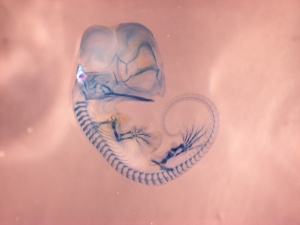The Anolis Gene Nomenclature Committee (AGNC) recently held an open discussion regarding our ongoing efforts to develop Anolis as a model system for integrative biology* and genomics at SICB 2012 in Charlestown, SC. To facilitate further discussion from the community I wanted to post a summary of this meeting here. If anyone would like to add to this discussion or propose additional objectives or concerns please leave your comments below. This is an exciting and fast-paced time for Anolis biologists and discussions such as this are necessary to continue the productive development of this genus for research in a post-genomic era.
The AGNC was formed to efficiently develop resources that will be useful to the Anolis research community. We opened the meeting with short presentations about our ongoing resource development efforts. Carlos Infante (UGA) described work from the Menke Lab to develop cell culture protocols that will be used to test transgenic constructs directly in anole tissues rather than distantly related model systems such as the mouse or chicken. He noted that they recently had promising results testing the piggyBac transposon system in cultured anole fibroblasts. Building on her poster presentation Jeanne Wilson-Rawls (ASU) described her experiences isolating and culturing satellite cells – small stem cells found in mature muscles – and her ongoing collaboration with Kenro Kusumi (ASU) studying the mechanisms of tail regeneration in A. carolinensis. Dr. Kusumi described a relatively new project aimed at obtaining genome and transcriptome sequences for A. apletophallus from Panama as part of a collaboration with the Smithsonian Tropical Research Institute (also see this abstract from E. Hutchins). Dr. Kusumi also reminded the audience of their recent release of additional transcriptome data for mid-stage A. carolinensis embryos (available through NCBI).
One of the AGNC objectives is to aid in the dissemination of laboratory protocols, genomic data, and to create a pipeline for integrating data from multiple populations and species (see below). Several web-based resources are now being created along these lines. Tonia Hsieh and Rob Kulathinal (Temple Univ.) concluded this introduction by describing their efforts to develop Lizardbase, a web portal for geographic and genomic data mining. While still in its development phase the portal promises to become a useful tool for the anole research community and its public outreach efforts as data is added. To build this database Drs. Hsieh and Kulathinal are soliciting geo-tagged data for this portal and are in the process of adding a searchable database of contributors.
Looking forward – Goals for 2012
After some lengthy discussion several new goals for the AGNC were put in place for 2012. It was largely agreed upon that the anole community needed better means of communication regarding available tissues, probes, protocols, and histological data. Two specific objectives were set: First, the creation of an Anolis Evo-devo and Genomics Wiki where technical questions could be asked and protocols shared. Along similar lines we have also set out to create a moderated Listserv similar to the widely used EvolDir.
One of the hallmark features of Anolis compared to many other model systems is the strength of our community that is interested in comparative biology. However, it is impractical for every lab to maintain colonies of numerous species and it is not sustainable over the long term as our community continues to swell. Many agreed that it would be wise to create a streamlined system with the museum community for depositing histological preparations and molecular reagents (cDNA, probes, etc.). It was also agreed that we could increase the usefulness of these materials while protecting their longevity by creating a more fluid system of digital archives. At this time the infrastructure is largely in place for both histological materials and digital files but standards have not been set regarding the information that should accompany each specimen nor the most useful means of searching already established databases.
Finally, additional molecular and sequencing efforts were discussed. Dr. Kusumi introduced the concept of a “molecular holotype” to our community and briefly discussed its potential utility as we look towards the future of comparative genomics. We also touched on how to target additional Anolis species for transcriptome and genome sequencing but it was nearly unanimous that A. sagrei should be the next species targeted by the community.
Meeting Attendees
Thomas Sanger (Harvard), Kenro Kusumi (ASU), Arhat Abzhanov (Harvard), Tonia Hsieh (Temple), Rob Kulathinal (Temple), and Jeanne Wilson-Rawls (ASU), Andre Pires da Silva (UT Arlington), Marc Tollis (CUNY), Bryan Falk (AMNH), Chad Watkins (UT Arlington), Elizabeth Hutchins (ASU), Katie Duryea (Dartmouth), Robert Cox (Univ. Virginia), Carlos Infante, Shane Campbell-Staton (Harvard), Michele Johnson (Trinity), Jerry Husak (Univ. St. Thomas), Alex Gunderson (Duke)
*(I hereby declare anoles the premier model system of eco-evo-physio-behavo-devo. Please use this phase as widely as possible! I am sure that it will catch on.)
- Short Faces, Two Faces, No Faces: Lizards Heads Are Susceptible to Embryonic Thermal Stress - December 15, 2021
- The Super Sticky Super Power of Lizards: a New Outreach Activity for Grade-Schoolers - April 9, 2018
- Updates on the Development of Anolis as a “Model Clade” of Integrative Analyses of Anatomical Evolution - September 4, 2017




2 Pingbacks